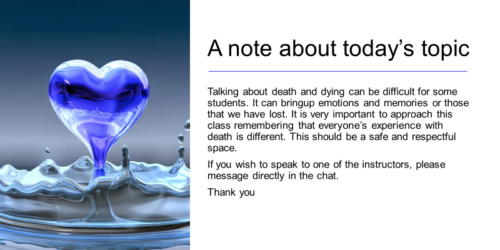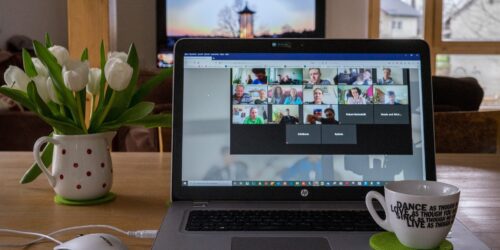
Accommodating and Supporting Students with Disabilities: Conestoga Faculty Stories
Stories curated by Elan Paulson and Sara Kafashan
Increasing numbers of students with disabilities are attending colleges in Ontario (Learning Disabilities Association of Ontario, n.d.). In fact, from April 2017 to April 2018, we had 1,334 students with a disability at Conestoga College, and this number increased to 1,380 from April 2018 to April 2019. And, according to Conestoga’s 2021-2024 Strategic Plan (see p. 13), ensuring inclusivity to promote student academic, personal, and professional success is a priority for our institution.
However, as Black, Weinberg, and Brodwin, have noted: “faculty attitudes still create barriers to an equitable educational environment for students with disabilities” (2014, p.1). Faculty misconceptions around the definition of disability and how disability presents for learners, ultimately, contributes to these attitudes and a lack of preparedness to better support students (Gin et al., 2020; Hansen & Dawson, 2020).
To improve understanding and improve faculty preparedness, it can be helpful to learn what accommodations and inclusive teaching can look like in the post-secondary classroom. Below are vignettes by Conestoga faculty who have supported students with disabilities in their courses. These stories explore accommodations and modifications for students with disabilities, personal faculty experiences with inclusivity, and the impact of a making moves towards inclusive teaching on students.
For faculty support with accommodations and accessible learning, and to contact Accessibility Services or an Accessibility Advisor, see the Student Services Accessible Learning webpage.
Before moving to these faculty stories, review this Hub post, A Foundational Understanding of Accessible Teaching and Learning at Conestoga College (by Sara Kafashan), for a series of key terms, definitions, and shared understandings related to accommodations and supporting students with disabilities.
Reducing Delivery Speed for Learners
“I have a tendency to speak very quickly in the classroom, and also continued speaking while writing on the white board in the classroom. During the current lockdown and remote delivery I have had the chance to look at my lecture recordings, and see that I occasionally still do speed up.
I had a student who this was causing a problem for, and she took the time to meet with me to discuss. I have always appreciated the student coming forward and taking the time. It has hopefully made me a better classroom facilitator, and definitely made me more aware of how some students benefit from a slower pace.
Being someone who learns from seeing and doing, it was a reminder of different learning styles, and the importance of oral delivery for some learners.
My first class is this morning and I just put a sticky note beside my camera to remind myself to tell the class this.” – Faculty Member, School of Business
Visit this page for information about recording lectures.
Classroom Adjustments and Supports for a Deaf Student
“Each semester I always seem to have a few students with an accommodations letter. The most interesting situation was just in the Winter 2021 semester. There was a student in my class that was deaf, so the classroom adjustments needed to accommodate the student were a little more extensive than the other students that I have had in the past.
Of course, the winter semester was conducted [online] so this meant our classes were held in Zoom. I was grateful that there was additional support for the student in our classroom. We had three extra support staff attend class (2 ASL interpreters and 1 note taker). However, I teach accounting and this class is challenging for students and I feared these additional resources would not be sufficient. The terminology we use can be technical and I was concerned the interpreters would struggle. Therefore, I ensured to engage both differently and frequently with this student.
From a Zoom perspective, it was important to enable closed-captioning and to always face the camera and be purposeful with the way I moved my lips when I spoke. It was also important to pin the interpreters so that their images would appear on the recording. However, most of the magic was outside of Zoom. I emailed frequently to ensure our classroom environment was meeting her needs. I also setup a private YouTube channel that was just for the two of us. Here, I posted videos that would more easily allow me to edit the closed captioning to ensure its accuracy and I created additional content just for the student.
Overall, the experience was very positive. It was obvious to tell that the student appreciated my effort, and the emails of appreciation made my heart melt. The interpreters were also a welcome addition to my classroom. They were professional and friendly, and together we were able to engage in meaningful ways.” – Kyle Nickason, School of Business
Visit this page for information about Conestoga’s volunteer notetaker program.
Supporting Students with Additional Devices
“I teach Spanish language and culture. I had an experience in [an online] class last semester. One of my students needed an additional device as stated on an accommodation letter. So, I decided to email the student’s advisor to learn how could I support the student. She recommended to email the students to establish a bridge of communication, ensure the student was comfortable and the student explained me about the student’s device, and the student appreciated I asked.
This semester, I didn’t have Zoom meetings. My course is asynchronous, there is not much interaction face to face with the students. I have uploaded a weekly announcement, a short video of myself introducing the content. Week by week, I have also reminded students to write me or come to see me if they need help. Students with accommodations came to see me or wrote me emails when they had a question. However, I think the weekly reminder helped everyone.”- Betty Munera, School of Interdisciplinary Studies
Visit this page to contact an Accessibility Advisor.
Teaching from the Perspective of a Live Captioner
“In addition to teaching part-time at Conestoga, I have recently trained and begun working as a Live Captioner, specifically for education sessions (mostly post-secondary, but some high school and elementary as well). I found the experience of doing this training extremely challenging, since working as a Captioner requires using many of the same skills I used in my academic work and teaching in completely different ways. However, I also found this training process very enlightening in terms of my own teaching.
Even though I have tried in the past to create an inclusive environment in my classroom, this training made me realize that there were certain things I was doing without even thinking that would have made my classroom less accessible for all of my students. Many of these things simply have to do with enunciation, pacing and/or tone in speaking, such as my unfortunate tendency to speed up at the end of sentences or the fact that I would turn my back to the classroom to write on the board, while continuing to speak. In any case, this experience was a really good reminder to me that inclusivity in the classroom is a continual practice and that it also requires not only one’s own commitment to principles of accessibility, but also often the ability to see oneself and one’s teaching practices from a different perspective.” – RJ Mcarthur, School of Interdisciplinary Studies
Visit this page for more information about assistive devices and alternate formats.
Personal Experiences with Inclusion
One of my younger siblings was diagnosed with a learning disorder in grade 2, and I watched her struggle through school and my parents push to get her the equipment and learning materials that she needed. Although times have changed a fair bit since then, I do my best to ensure make sure a student doesn’t feel that they are at a disadvantage in my class, or their needs being left out of the learning environment because of an inconvenience.
What’s important is making sure that all students are presented with an equal opportunity to participate in class and engage in the content. The accommodation forms are confidential and discretion is extremely important. It is amazing to see when a student advocates for themselves, speaking openly about their needs to me, but not all students are comfortable doing so and that is okay too.
In the first class of every course, I always make a point to let the whole class know that if they need something in particular from me to improve their learning experience in the class, to let me know; providing examples like, a print out of something that was mentioned, or sharing links or more visual examples, speaking louder, closed captioning and so on. I try to have all of these things at the ready in advance, but it doesn’t hurt to mention it, just in case. What is important is setting the stage at the beginning—creating an open, safe and respectful space (be it online or in the classroom) where students feel that they are allowed to speak up and advocate for their needs. If I’m ever at a loss of what to do, I’ll share information for Student Success Services and/or Accessibility Services with the student in a neutral, but empathic way. I look at creating an inclusive learning environment as something that I get to do, rather than something that I have to. What a great thing it is to provide a solid foundation of a classroom to facilitate learning!” – Faculty member, School of Workforce Development
Visit this page for questions and reflections on equity and inclusion during the pandemic.
Giving Choices to Learners
“I have taught many students with different accommodations throughout the years, from needing longer time on assignments and tests to providing a Kurzweil version of the test, an assistive tool the provides a speech-to-text version of the test. One thing I do is try to create a variety of activities and learning opportunities to allow all students with different learning styles a chance to learn in their own way. I recognized early on that some students need to get up and move around (this just isn’t something for young children) so I have always allowed people to get up and leave as needed provided they are not disruptive to the class as a whole.
Rick Lavoie has always been an inspiration to me and one thing I have taken from his F.A.T City Workshop series “How difficult can this be” is that the definition of does not mean giving each student the same thing, it means giving each student what they need. Everyone of our students may require something different to succeed and if we can accommodate it, we should. With online learning and Synchronous Online it really isn’t that difficult to record our sessions, use close captions and post them, just reminding students this is going to be done so that they can turn their cameras off if they want to.
Providing choices and reminders of services that are available gives every student the opportunity to use them. I tend to let the whole class know about services that are available and how to access them to show that this is a regular process for everyone. I also let my classes know that if I use a term that they are not familiar with or find offensive to please stay at the end of zoom or contact me so that we can talk about it. I leave time at the end for students to be able to talk to me and express themselves at the end of class and provide opportunities for private conversations as well.” – Treena Pixner, School of Health and Life Sciences
Visit this page for more information on students and web cameras in class.
Have a story about how you have addressed diverse learner needs through inclusive practices in your teaching? Want to share what happened and your reflective process here? Contact Teaching and Learning Consultants, Elan Paulson at epaulson@conestogac.on.ca or Sara Kafashan at skafashan@conestogac.on.ca.
References
Black, R.D., Weinberg, L.A., & Brodwin, M.G. (2014) Universal design for instruction and learning: A pilot study of faculty instructional methods and attitudes related to students with disabilities in higher education. Exceptionality Education International, 24(1), 48-64. https://ojs.lib.uwo.ca/index.php/eei/article/view/7710
Gin, L. E., Guerrero, F. A., Cooper, K. M., & Brownell, S. E. (2020). Is active learning accessible? Exploring the process of providing accommodations to students with disabilities. CBE – Life Sciences Education, 19(4). https://www.lifescied.org/doi/10.1187/cbe.20-03-0049
Hansen, K. D., & Dawson, D. L. (2020). “We Can Do Better”: Community college faculty preparedness for teaching students with learning disabilities. Journal of Diversity in Higher Education, 13(4), 309–319. http://ra.ocls.ca/ra/login.aspx?inst=conestoga&url=https://search-ebscohost-com.eztest.ocls.ca/login.aspx?direct=true&db=pdh&AN=2019-56722-001&site=ehost-live&scope=site
Learning Disabilities Association of Ontario, (n.d.). Learning Disabilities Statistics – Learning Disabilities Association of Ontario – LDAO







2 Responses